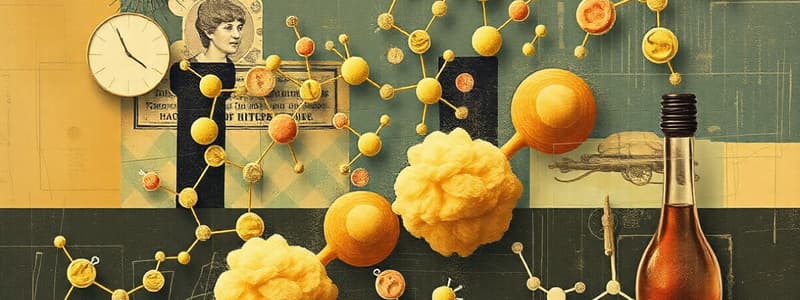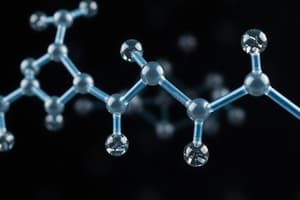Podcast
Questions and Answers
What are biomolecules?
What are biomolecules?
Biomolecules are molecules that occur naturally in living organisms.
What are some examples of biomolecules?
What are some examples of biomolecules?
Carbohydrates, proteins and nucleic acids are some examples of biomolecules.
Biomolecules consist mainly of carbon, hydrogen and phosphorus.
Biomolecules consist mainly of carbon, hydrogen and phosphorus.
True (A)
Carbohydrates are the most abundant organic molecules in nature.
Carbohydrates are the most abundant organic molecules in nature.
Signup and view all the answers
What is the empirical formula of many carbohydrates?
What is the empirical formula of many carbohydrates?
Signup and view all the answers
The hydrogen and oxygen in a carbohydrate are always present in the proportion of two hydrogen atoms to one oxygen atom.
The hydrogen and oxygen in a carbohydrate are always present in the proportion of two hydrogen atoms to one oxygen atom.
Signup and view all the answers
Many substances not carbohydrates contain hydrogen and oxygen in the same proportion as water.
Many substances not carbohydrates contain hydrogen and oxygen in the same proportion as water.
Signup and view all the answers
($C_6H_{12}O_6$) do not contain hydrogen and oxygen in the proportion of $H_2O$.
($C_6H_{12}O_6$) do not contain hydrogen and oxygen in the proportion of $H_2O$.
Signup and view all the answers
What are carbohydrates actually or potentially convertible to?
What are carbohydrates actually or potentially convertible to?
Signup and view all the answers
Study Notes
Carbohydrates: General Idea
- Biomolecules are naturally occurring molecules in living organisms
- All life forms are composed of biomolecules
- Biomolecules include macromolecules like carbohydrates, proteins, lipids, and nucleic acids
- Biomolecules also include smaller molecules like metabolites and natural products
- Biomolecules consist mainly of carbon, hydrogen, nitrogen, oxygen, sulfur, and phosphorus
- Biomolecules are large molecules with covalently bonded atoms
Carbohydrate, General Idea
-
Carbohydrates are the most abundant organic molecules in nature
-
Carbohydrates are defined as polyhydroxy aldehydes or ketones and their derivatives
-
Many carbohydrates have the empirical formula (CH₂O)ₙ
-
This formula originally suggested a "hydrate of carbon" relationship
-
The hydrogen and oxygen atoms in carbohydrates are often in a 2:1 ratio, like in water (H₂O)
-
Many other substances (e.g., acetic and lactic acid) also contain hydrogen and oxygen in the 2:1 ratio but are not carbohydrates
-
Some carbohydrates, like Rhamnose (C₆H₁₂O₅), do not have the 2:1 hydrogen to oxygen ratio
-
Carbohydrates are actually or potentially (convertible) to hydroxyl aldehydes or ketones
-
Most carbohydrates are polyhydroxy aldehydes or ketones
Ring Structure of Sugars
- (Image) Various ring structures of sugars are shown
Studying That Suits You
Use AI to generate personalized quizzes and flashcards to suit your learning preferences.
Description
Explore the fundamental concepts of carbohydrates and their role as biomolecules in living organisms. This quiz covers the structure, composition, and significance of carbohydrates, including their empirical formulas and classifications. Test your knowledge of these essential organic compounds.




